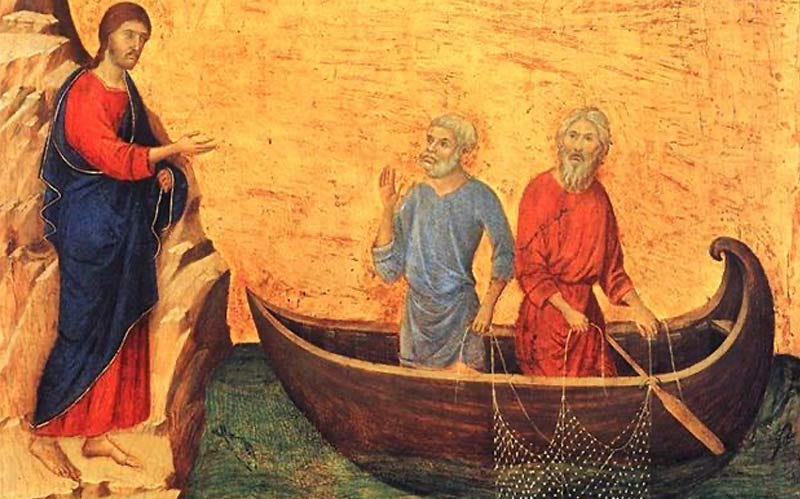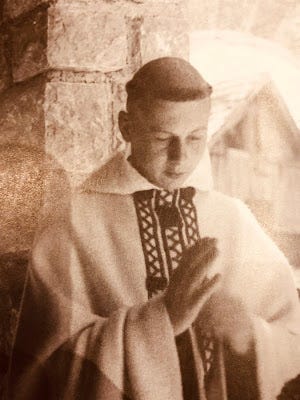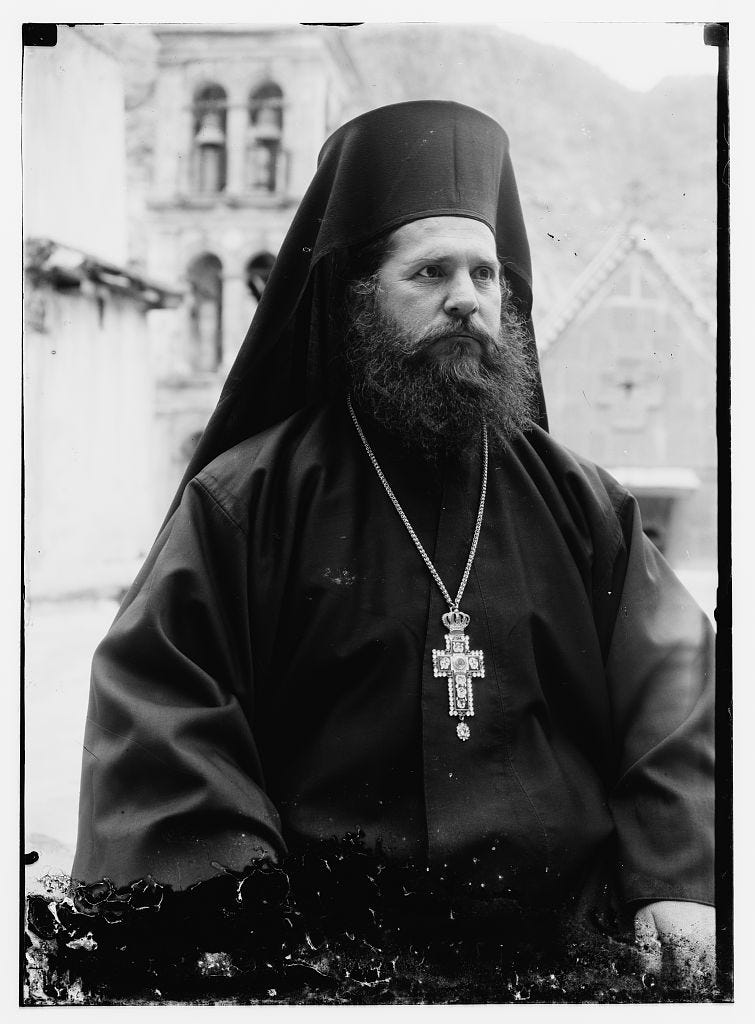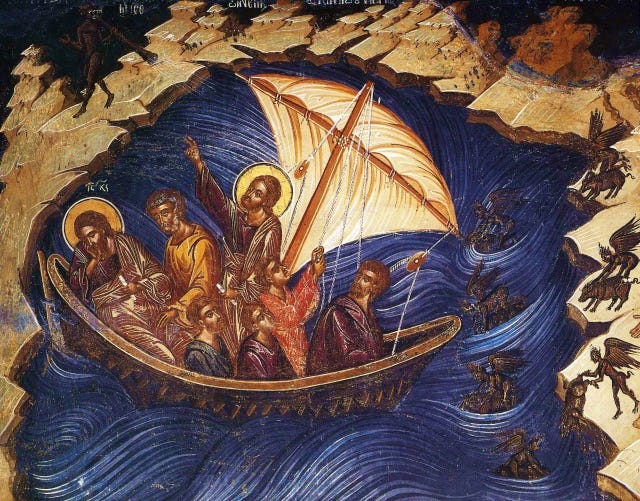Interiority and Exteriority in Peter and Andrew
Symbolism of Peter and Andrew in Duccio's masterpiece

In the Italian Gothic masterpiece “The Calling of Sts. Peter and Andrew” by the Italian master Duccio (c.1311), we find a magnificent piece of art that contains volumes of meaning compressed into a single sacred image. Primarily it depicts an important event described in the Gospels; but it also is a multi-layered image of the relationship between the East and the West.
We see Christ standing on the shore speaking to two fishermen standing upright in a boat. These two men are St. Peter on the left and St. Andrew on the right. Both are depicted according to their traditional typologies: Peter has short, cropped white hair with a bald spot on top and a short white beard, while Andrew has long white hair and long white beard. Instantly these two characters are recognizable to Christians of both the East and the West because the iconographic language here has largely been maintained. But stare at the image longer and more details will jump out at you.
Exteriority and Interiority of Peter and Andrew
Peter is standing faced towards the shore with his right hand raised up, as if he were about to respond to the call, while holding on to the net with his left hand, as if to bring in the net. Meanwhile, Andrew seems focused on the net, pulling it in with both hands and turns his head only slightly, as if interrupted by the voice from the shore.
Peter is wearing a blue tunic while Andrew wears a red tunic. These correspond to the colors of Christ’s garments. Christ is wearing a red tunic underneath his blue toga. (This color scheme also is widely maintained -but not strictly- historically throughout the iconography of both East and West.) Visually this connects Peter with Christ’s outer garment, and Andrew with Christ’s inner garment.
Look at the shape of the boat itself, and you will see that the left end of the boat (on Peter’s side) is pointed in a linear way towards Christ like an arrow, while the right end (Andrew’s side) is curved in on itself and points to Christ like a spiral.
Together with the posture of these two Apostles and the colors of the garments, this suggests that Peter is related to exteriority, outward orientation, and linearity while Andrew is representative of interiority, reflection, and curved-ness.
It may be beneficial to recall here that these associations align well with their characterization in the four Gospels. Peter is often represented in the Gospels as erratic, jumping feet first in every situation, eager to speak straight to the point and often too soon. On the other hand, Andrew is first a disciple of St. John the Forerunner (the Baptist) and then in obedience is sent by him to follow Christ. Although brothers, Andrew is depicted in the Gospels as obedient and reflective in contrast to his brother Peter.
There is a subtle clue in this image that shows in fact that the artist is not actually attempting to recreate a historically accurate scene. In the Gospels, it is recorded that Andrew heard the call first and then ran to get his brother Peter and bring him to Christ as well. Nevertheless, in this image, they are both hearing the call at the same time, as suggested in the Gospel of John, which reveals the artist’s intention to reveal the hidden meaning of the calling of these two brothers rather than taking a photograph of the historical event. Regardless, the image contains even more layers of symbolism in the depiction of their hair.
Spiritual Descendants of Peter and Andrew
It is important to remember here that St. Peter is recognized as the first Bishop and Patriarch of Rome, while St. Andrew is remembered as the first Bishop and Patriarch of Byzantium / Constantinople. The Latin and Greek churches that sprang from these two brothers each continued to carry on their founder’s spirit and unique characteristics.
Turn again to the painting by Duccio above and see that Andrew has long hair and long bear while Peter is depicted in short hair with a bald spot on top of his head. This unique haircut is associated with the monastic tonsure of the Western Church, and used almost universally until the 20th century among the Latin monks. (There are several monasteries that still maintain this ancient tradition.1)

On the other side of the boat, Andrew is presented with long hair and long beard. This is the traditional hairstyle of the monks and priests of the Eastern Church, which is maintained ubiquitously to the present day. Even in their hairstyles, it is as if this image by Duccio captures the dichotomy between East and West in a remarkably coherent and succinct way.

Two brothers, one boat
It cannot be overstated that the masterpiece by Duccio, aside from showing the uniqueness of Peter and Andrew, also shows their solidarity. They are after all brothers! They are both fishermen pulling in one net, being called to be fishers-of-men by the one King-fisher-of-men. Goodness, they are in one and the same boat for crying out loud!
The boat throughout Eastern and Western iconography is emblematic of the Church. There are many, many references throughout Scripture and Tradition that make this symbolism clear. The Ark of Noah is likened to the Church by Church Fathers, as is the Barque of Peter during the calming of the sea. The vessel that carries Christ and His Apostles is the Church.

The image by Duccio therefore presents a description of the nature of the One Church in her two constituent branches or families: Western and Eastern. Despite ongoing disagreements and misunderstandings, both are called by Christ. Both are within the ship of Christ. Both are headed towards Christ.
Apocaliptic image
Seen from the point of view of an apocalyptic image, the ship is oriented towards Christ, hauling in a load of fish to deliver to Him. This is representative of the Church bringing all peoples to Christ at the end of time.
While the boat is sailing - through the chaotic sea of this present age- there are dangers and risks. But Christ is our destination and He calls to us from the firm shore of our eternal homeland, bidding us from the future to come His Way. He calls to us from the eschaton, which is more real and solid than our present fluid state of the world.
While on the boat, there has to be an end that points towards where we are going and an opposite end on the side of where we have been. In the image, since they are responding to Christ and headed towards Him, that means Peter is in the prow, or front side, of the boat, and Andrew is on the back side, or aft.
Being in the prow of the boat is just where Peter would like to be, I reckon. He wants to look out and be the first in line. After all, in every list of the Apostles in the Gospels, Peter is always listed as first. Meanwhile, Andrew is likewise content to be in the aft, since that is where the steering oar is kept. From that position, he can stay focused on the target destination and silently keep the vessel on track.
In this light, this image is showing us that Andrew is guiding Peter to Christ by steering the boat towards Christ. It could even be said that in this way this image subtly combines all the Gospel accounts of the calling of these two apostles, thus including the simultaneous calling, AND Andrew the First called, leading Peter to Christ.
Of course, since we are all spiritual descendants of Andrew and Peter, we find ourselves depicted in this image as well. We are the fish in the net!
Hopefully this reflection on this masterpiece by Duccio helps people to start to understand the deep symbolism that it contains, as well as its coherence with the Eastern and Western traditions of the One Church.
see the Abbey of Barroux, among others: https://www.barroux.org/historique-du-monastere/




I never would have noticed the symbolism in the hair! This is why Christians need conversation!!!
EPIC! Thank you so much for putting this together Miguel! What a profound commentary. And thank G-D for mr. Duccio and the image! Beautiful how after some time the - right/left, center/outside, masculine/feminine, head/body, West/East, body/spirit-blood, light/dark- symbolism becomes so clear yet never ending in depth while before it seemed contradictory.
Here it is really beautifully seen in how st. Peter is the one closer to Christ, yet he is also further from Him as he is the outer garment, the solid hierarchical and legislative body of the Western Church. While st. Andrew is further, but he is actually the inner garment - the flowing living spirit, the red blood, point indirectly to Christ.
(also now it comes to me how it is also Peter who first explicitly points to Jesus as being the Messiah (names Him directly which a huge deal! as naming something is having authority over it) - there is a sense in the story that he almost shouts it out loud while Christ is telling them to keep quiet about Who He really Is not to ruin the mystery prematurely. Also interestingly- from when i can remember i always imagined this confession of Peter took place when they were on the boat together after the Calming of the seas, the image is just inseparably interwoven for me, which is interesting as the two accounts are not even next to each other in the Gospels. But it always seemed right that way.)
It is so beautiful how the head can in its pride think it is the one who is leading the way because it is on the front and shouts around loudly while the inner body is quietly steering the whole time at the back - keeping the spirit and actually is the living heart even though it is on the outside. As the king must always remember he is the head only as long as he gathers in himself all the little servants of his kingdom. Thus Peter is told by Christ at last that if he loves Him then "herd His sheep!". As if He is saying "if you love me, dont look directly at me but look below/behind and care for the sheep - and also remember your brother who brought you to Me". But also other times when you are walking on the waters- "then only look directly at Me and dont let your eye slide even a tiniest bit or you will sink." Which show beautifully how "symbolism" cannot be systematized into rules as Jonathan often reminds us crucially.
The best way to hint at the beautiful relationship i reckon is "the last is first and first is last". This image shows us very well how that is simply a description of reality not a moral statement and neither last or first /center and edge is good or bad as such. They are simply what they are.
Also one last obvious thing which i dont think was pointed to in here is that in this image Christ and thus also firm ground is on the West or on the Right side. Which is also our left side from looking opposite at the image and shows how our right is left in the ultimate view of G-D and to follow Him we have to go against our selves or "deny ourselves" which is our left side. Just as Peter was told to "get behind Christ and dont oppose Him".